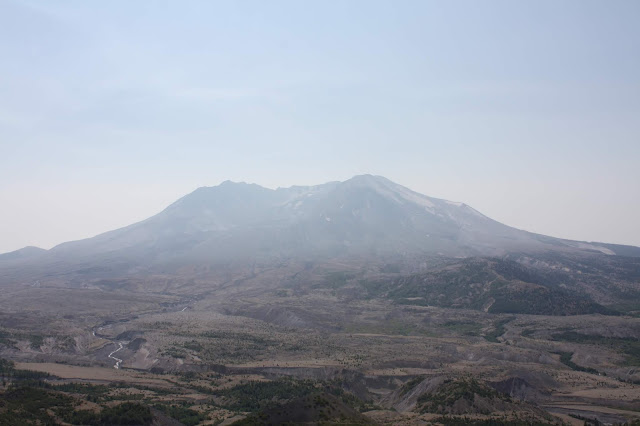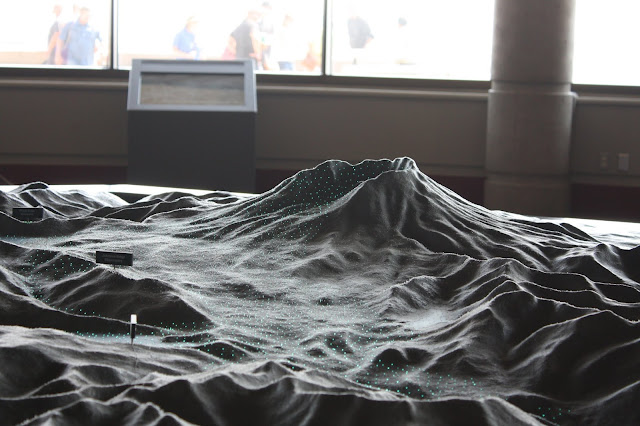Driving through Washington and Oregon, you will undoubtedly see majestic mountains about. While planning our trip, we knew that we had to add some mountain hiking. We just were unsure of the location. I settled in on Mount St. Helens in Washington partly because I so vividly recall learning about the 1980 eruption. My interest was piqued and I am glad we went! We spent nearly a day exploring
Mount St. Helens National Volcanic Monument savoring both wonderful hiking and learning experiences.
 |
| Amazing views showing the dramatic side of nature. |
Throughout our drive through the monument, we stopped at various viewpoints of significance. Our first top was at the edge of the blast zone. Standing at the edge greeted by a beautiful suspension bridge and the forested folds of the mountain, we could hardly believe that we were on the edge of the destruction that enveloped the area in 1980. As our day unfolded, we would learn more about the eruption, how nature has returned to the area and the treasure the monument is today.
 |
| Standing on the edge of the blast zone, it is remarkable to see the return of the forest in this area. |
Our next stop was at the
Forest Learning Center which is one of several learning centers available for exploration. Forest Learning Center is free and provides and opportunity to orient yourself before hiking. We asked one of the rangers more details about the trails and grabbed some maps. I highly recommend grabbing maps in case their are issues with your phones. Inside, there is a wonderful collection of exhibits and hands-on elements for kids. It is the place where I first learned about the Zone of Silence explaining how those on the mountain and nearby did not hear the eruption while those far away did.
Outside, we were treated to more magnificent views including the Columbia River gorge.
 |
| Incredible folding and you can see Mount St. Helens faintly in the distance. |
Exploring a Lake Created by an Eruption:
Next, we went hiking at Coldwater Lake. Coldwater Lake formed when the 1980 eruption blocked its outlet Coldwater Creek. The lake was originally full of mud and debris. But, natural processes including that of bacteria and other microrganisms helped bring it to life.
 |
| Peaceful Coldwater Lake. I could spend a day relaxing here. |
Coldwater Creek featured several boardwalk sections where you could walk out into the lake. We reveled in the completely serene landscape.
 |
| Walking the boardwalk at Coldwater Lake at Mount St. Helens National Monument. |
As you continue to drive up the mountain, you will discover more overlooks. We sometimes noticed them too late to stop. The good news is that we were returning using the same route and could stop again. Our drive encompassed about 50 miles on State Highway 504.
 |
| Fantastic viewpoint along part of the Boundary Trail. |
Johnston Ridge Observatory:
Johnston Ridge and Johnston Ridge Observatory are named for David Johnston, a volcanologist who was on the mountain and perished during the eruption. I can't think of a better way to commemorate him than with an observatory with this view:
 |
| View of the crater of Mount St. Helens from the Johnston Ridge Observatory. |
Inside the observatory, there are several exhibits on the eruption and what was learned from it. The volcano diorama is one of the focal points of the observatory and shows the paths of the eruption's destruction.
 |
| Diorama showing the path of destruction of the blast. |
Throughout the Mount St. Helens National Volcanic Monument, you can see trees snapped like toothpicks by the eruption. One is part of an exhibit inside the observatory. The blast zone was about 19 miles in radius obliterating or carrying everything away in its path. The blasted trees are evidence of the force of nature during the eruption. This tree was 9 miles from the mountain.
 |
| Trees were obliterated by the lateral blast of the volcano. |
We also learned about first hand accounts from survivors who were on the mountain that day. Other exhibits allowed us to peek at equipment used to detect impending eruptions. A film was also available to watch but we were anxious to explore!
 |
| Stories from survivors of the 1980 eruption. |
The views at Johnston Ridge are incredible and somewhat otherworldly. The detail you can see from various points at Johnston's Ridge is captivating:
 |
| Stunning view of Mount St. Helens from Johnston Ridge. |
Here I am just to give you perspective:
Around us, we noted trees shredded by the blast:
 |
| Trees that were shredded by the 1980 blast. |
On this trail is also a memorial to those that perished during the eruption:
 |
| Poignant memorial to those that perished during the Mount St. Helens eruption. |
Hummocks Trail:
On our way back from the observatory before heading back to Portland, we hiked part of Hummocks Trail. I would like to explore the Hummocks Trail more in the future. It does exemplify both the reemergence of nature as well as some of the remaining destruction of the eruption. There also are some wetland areas to check on the trail.
 |
| Hiking the Hummocks Trail at Mount St. Helens |
After sampling the trail, it was time to head back to Portland. We loved our adventure to Mount St. Helens. We learned a lot about volcanoes and the eruption. We also experienced unique views and witnessed both the strength and healing powers of nature. There is much more to explore at Mount St. Helens, so I look forward to returning!
Things to know:
- Be sure to bring adequate water and food supplies with you.
- Grab a map at the Forest Learning Center and take the opportunity to ask details about trails.
- There is little tree cover, so you want to be sure to bring sunscreen. I also recommend layers that can easily be changed because it can get hot fast.
- We visited Mount St. Helens from the west. There are other hikes on other sides of the mountain including some cave hiking. Check out the Washington Trails Association for more info and tips.
- If you are planning a climb, you must have a permit. I suggest reading more about climbing from Mount St. Helens Institute.
- If you are not so into hiking but would like to enjoy the views, the drive through the monument is worth it.
- The Johnston Observatory has a small fee, but I think it is worth exploring.




















Post a Comment